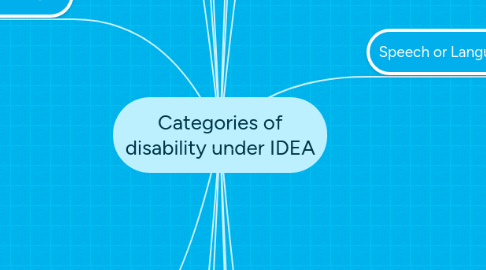
1. Hearing Impairment
1.1. Enhance Your Understanding of Your Student's Hearing Loss and Special Communication Needs
1.2. Keep Track of Your Student's Progress to Make Decisions for Intervention and Education
1.3. Help Your Student Stay on Schedule with Speech, Language and Communication Skills
1.4. Case Studies
1.4.1. http://www.hearingreview.com/2015/01/case-study-5-year-old-boy-unilateral-hearing-loss/
1.5. Assistive Technology
1.5.1. https://www.nidcd.nih.gov/health/assistive-devices-people-hearing-voice-speech-or-language-disorders
2. Multiple disabilities
2.1. Know the Needs, Play to the Strengths
2.2. Be Familiar with the Student's IEP
2.3. Make Modifications
2.4. Allow Partial Participation, As Necessary
2.5. Let the IEP Team Know What Program Supports or Modifications You Need
2.6. Assistive Technology
2.6.1. http://www.pathstoliteracy.org/technology-students-multiple-disabilities
3. Emotional Disturbance
3.1. Establish Open, Accepting Environment
3.2. Clearly State Class Rules and Consequences
3.3. Reinforce Positive Behavior
3.4. Teach Social Skills
3.5. Teach Academic Survival Skills
3.6. Assistive Technology
3.6.1. http://education4ed.weebly.com/assistive-technology.html
3.6.2. https://youtu.be/cPs4eDkar4I
4. Orthopedic Impairment
4.1. Instruction Focused on Development of Gross and Fine Motor Skills
4.2. Special Seating Arrangements to Develop Useful Posture and Movements
4.3. Securing Suitable Augmentative Communication and Other Assistive Devices
4.4. Awareness of Medical Condition and Its Affect on the Student (such as getting tired quickly)
4.5. Assistive Technology
4.5.1. Speech Recognition Software
4.5.2. Screen Reading Software
4.5.3. Augmentative and Alternative Communication Devices (such as communication boards)
4.5.4. Academic Software Packages for Students with Disabilities
5. Developmental Delay
5.1. Physical Therapy
5.2. Counseling and Training for the Family
5.3. Speech and Language Services
5.4. Psychological Services
5.5. Assistive Technology Links
5.5.1. https://youtu.be/0Zosc8dEBf8
5.5.2. https://youtu.be/FauUZhQXNNo
6. Autism
6.1. Parent Education and Training
6.2. Cognitive Behavior Therapy
6.3. Social Skills and Speech Therapy Training
6.4. Applied Behavioral Analysis
6.5. Sensory Integration/Occupational Therapy
6.6. Medication
6.7. Case Studies
6.7.1. http://leader.pubs.asha.org/article.aspx?articleid=2289534
6.8. Assistive Technology
6.8.1. https://youtu.be/IlpmVYX4NfQ
6.8.2. https://youtu.be/fWli1-84CNQ
6.8.3. https://youtu.be/dkSmsGgp8y4
7. Deaf-blindness
7.1. Audiological Services
7.2. Occupational and Physical Therapy
7.3. Vision Services
7.4. Speech and Language Therapy
7.5. Family Training, Counseling, and Home Visit
7.6. Assistive Technology
7.6.1. https://youtu.be/GkthqXO9IQM
7.6.2. https://youtu.be/6nYn2R0t0oQ
8. Deafness
8.1. Assistive Technology
8.1.1. https://youtu.be/h1s8WkvhV8U
8.1.2. Hearing Aids
8.1.3. Cochlear Implants
8.1.4. Bone-anchored Hearing Aids
8.1.5. FM System
8.1.6. Closed Captioning
8.2. Circular Seating Arrangements
8.3. Keep Front Seats Open for Deaf Students When Lecturing
8.4. Repeat Comments and Questions from Other Students
8.5. Have a Hearing Student Team Up with a Deaf Student
8.6. Face the Class While Speaking
8.7. Provide Transcripts of Audio Information
9. Other Health Impairment
9.1. Allow Extra Time for These Students to Shift from One Activity or Environment to the Next
9.2. Teach These Students Specific Techniques for Organizing Their Thoughts and Materials. Organize the Classroom Accordingly, and Keep All Materials in Permanent Locations for Easy Access
9.3. Allow Extra Time for Finishing Assignments or for Testing
9.4. For More Complex Activities, Simplify Steps to Make Them More Manageable
9.5. Seat the Student Close to the Teacher and Away From Any Peers That Might Be Distracting
9.6. Post a Daily and Weekly Schedule That Clearly Delineates Each Activity. These Schedules Can Then Be Used As Prompts to Direct the Student Back on Task
9.7. Keep These Schedules as Consistent as Possible, and Keep Unstructured Time at a Minimum
9.8. Assistive Technology
9.8.1. http://www.gmc-uk.org/accessibility/assistive_technologies/physical_impairments.asp
10. Specific Learning Disability
10.1. Teaching Strategies
10.1.1. Teaching Strategies for Students with Perceptual Difficulties
10.1.2. Teaching Strategies for Students with Attention Difficulties
10.1.3. Teaching Strategies for Students with Memory Difficulties
10.1.4. Teaching Word-Analysis Skills
10.1.5. Teaching Reading Comprehension
10.1.6. Teaching Writing
10.1.7. Direct Instruction
10.1.8. Assistive Technology
10.1.8.1. https://youtu.be/FbkQW4j9VgE
10.1.8.2. https://youtu.be/QdI_ddl0WyE
11. Speech or Language Impairment
11.1. Teaching Strategies
11.1.1. Helping Children with Articulation Disorders to Learn Proper Production of Speech Sounds
11.1.2. Helping Children Who Stutter to Speak More Fluently
11.1.3. Assisting Children with Voice Disorders to Improve Their Voice Quality
11.1.4. Helping Individuals with Aphasia to Relearn Speech and Language Skills
11.1.5. Assisting Individuals Who Have Difficulty Swallowing as a Result of Illness, Surgery, Stroke, or Injury
11.1.6. Evaluating, Selecting, and Developing Augmentative and Alternative Communication Systems
11.1.7. Enhancing Communication Effectiveness
11.2. Assistive Technology
11.2.1. https://www.princeton.edu/futureofchildren/publications/journals/article/index.xml?journalid=45&articleid=204§ionid=1330
12. Visual Impairment, Inluding Blindness
12.1. It's OK to Look and See
12.2. Audiovisual Presentations and Demonstrations Are Made Accessible to Severely Visually Impaired Students by Providing Verbal Explanations
12.3. Importance of Seating
12.4. Braille Materials Take An Exceptionally Long Time to Order and/or Prepare
12.5. Expect the Visually Impaired Student to Complete the Same Assignments As the Rest of the Class
12.6. Independence Is of Primary Importance
12.7. Doors and Drawers
12.8. Address Students by Name
12.9. Assistive Technology
12.9.1. https://youtu.be/34hBBYmhNLE
12.9.2. https://youtu.be/rXhnDX_eVn8
12.9.3. https://youtu.be/lLaUx7BJ4r0
12.9.4. https://youtu.be/uBX_raHKhtA
12.10. Case Studies
12.10.1. http://www.hltmag.co.uk/apr08/stud02.htm
13. Traumatic Brain Injury
13.1. Teaching Strategies
13.1.1. Provide Repetition and Consistency
13.1.2. Demonstrate New Tasks, State Instructions, and Provide Examples to Illustrate Ideas and Concepts
13.1.3. Avoid Figurative Language
13.1.4. Reinforce Lengthening Periods of Attention to Appropriate Tasks
13.1.5. Probe Skill Acquisition Frequently and Provide Repeated Practice
13.1.6. Teach Compensatory Strategies for Increasing Memory
13.1.7. Be Prepared for Students' Reduced Stamina and Increased Fatigue and Provide Rest Breaks as Needed
13.1.8. Keep the Environment as Distraction-free as Possible
13.2. Assistive Technology
13.2.1. https://youtu.be/9HXbVNTf_Ks
14. Intellectual Disability
14.1. Teaching Strategies
14.1.1. Teach One Concept or Activity Component at a Time
14.1.2. Teach One Step at a Time to Help Support Memorization and Sequencing
14.1.3. Teach Students in Small Groups, or One-on-one, if Possible
14.1.4. Always Provide Multiple Opportunities to Practice Skills in a Number of Different Settings
14.1.5. Use Physical and Verbal Prompting to Guide Correct Responses, and Provide Specific Verbal Praise to Reinforce These Responses
14.2. Assistive Technology
14.2.1. http://www.spectronics.com.au/blog/tools-and-resources/using-ipads-with-students-with-intellectual-disabilities/

